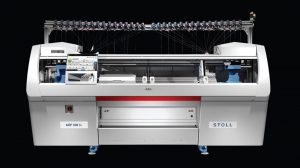
Themes in knitting evident at ITMA 2023 include advanced materials, robotics and AI, as well as sustainable production.
By Dr. Andre West, Technical Editor
ITMA, a pivotal platform for engaging textile and apparel leaders and machine makers worldwide, gathered 110,000 international participants at its latest edition held in Milan, Italy. This nexus facilitates insights and alliances, extending to a critical component constantly growing and innovating, the knitting machine industry.
During ITMA 2023, with a focus on “Pivoting Towards Digital Trans-formation and Circularity,” four themes in knitting emerged:
1. Advanced materials with an eye on sustainability are fueling innovative technical textiles with multi faceted functionalities that span fashion, sports, architecture, defense and healthcare.
2. Robotics and artificial intelligence (AI) are fostering automation in knitted textiles while 3D digitization reshapes supply chains. Open AI’s early integration allows for retooling and efficiency that were not possible before, and autonomous machines have started to amplify their reach.
3. Remarkable advancements have propelled textile production, defied pandemic expectations and encouraged technology introspection.
4. Sustainable practices are integrating innovative materials and processes, aligning with ecological goals. Creating virtual garments using 3D technology is accelerating prototypes and cutting waste.
The article breaks the knitting industry into key machine markets — flat, shoe/socks, circular and warp knitting. It is impossible to cover every machinery manufacturer’s innovations, and the report focuses on what is new rather than what is best. Some of these machine innovations will prevail and be featured at the next ITMA four years from now as a standard component.
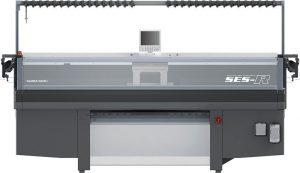
Flat Knitting Machines
Japan-based Shima Seiki Mfg. Ltd. showcased its innovation prowess at ITMA 2023, unveiling the newly branded R-Series — meaning Reborn. Moving away from the traditional green and blue knitting machines, the new line features nine grey flat knitting machines, including a cutting-edge prototype faster WHOLEGARMENT® machine. Hundreds of intricate fabric samples spanning fashion, sports, medical applications and more, were displayed on a bustling stand.
Shima Seiki embraced the traditional ethos of ITMA by introducing previously unveiled machinery while engaging clients to obtain feedback in this microfactory-oriented testing ground. The flagship WholeGarment knitting machines finally are part of the Shima Seiki ecosystem after more than 20 years of fine-tuning, streamlining planning, design and production. These machines enable agile sampling and custom knitwear crafting in limited quantities, enhancing efficiency and fit with the sustainable economy of far less waste with superior quality.
Shima Seiki revealed its fifth generation SWG-XR prototype knitting machine. This iteration showcases remarkable speed, quality, efficiency and dependability strides. An homage to the groundbreaking SWG-X, the pioneer four-needle bed device that birthed seamless, WholeGarment knitting, the SWG-XR introduces innovative attributes like a spring-based mobile sinker system, a compact carriage with four knitting systems and automated yarn carriers. These features boost productivity by more than 25 percent compared to the preceding MACH2 XS model. There were three prototype SWG-XR machines, each integrating new facets like needle defect detection, premium 18-gauge fabric knitting and automated yarn end finishing. SWG will now become a household name for knitwear manufacturers, just like the SEC and SES did in previous generations.
Not to be forgotten, Shima Seiki’s esteemed SES series was a pioneering machine in flat knitting, transforming garment creation with single garment, shaped piece innovation. Aiming to redefine the SES’s scope, the new prototype SES-R emerges, incorporating a novel sinker system for dimensional sinker patterns and short-row knitting paired with a pioneering transfer jack system. Enhanced productivity arises through automated yarn carriers, particularly intarsia, combined with loop pressers for inverse plating and inlay knitting. The exhibit showcased two SES-R prototypes, which emphasized the transfer jacks and highlighted the loop pressers.
In this author’s opinion, Dr. Shima’s legacy will always be innovative glove knitting technologies, which were showcased at ITMA in the SFG-R glove-knitting marvel. The machine boasts a new sinker system, belt-driven carriage and automated yarn carriers, which results in gloves that impeccably follow hand contours, enriching fit and design potential. The SPG-R pile glove knitting machine, a stalwart since 1979, also integrates a refreshed sinker system, belt-driven carriage and automated yarn carriers. This revitalization expands color choices, design possibilities, and market diversification into cozy gloves and mittens.
Furthermore, Shima Seiki is integrating its software and cloud presence wherever it can, giving its customers a genuinely virtual seam-less online package. The Apex4 series graphic design system has under-gone enhancements in knit programming, 3D capabilities, speed and user-friendliness. These augmentations — along with the cloud-based design system ApexFiz, digital yarn sourcing web service Yarnbank, and Shima’s Datamall digital content web service — enable users to procure valuable data for fashion planning, production, and sales; while Shima KnitManager functions as production management software. In addition, Shimanavi for training and the Shima HelpCenter all contribute to Shima Seiki’s one-stop shop for operations and support.
Germany-based Stoll — now also known as KARL MAYER STOLL Textilmaschinenfabrik GmbH after the company became part of the Germany-based Karl Mayer Group— expanded the renowned adaptability of its ADF series and finds total expression in the ADF 530-32 ki FLEX E7.2, which pushes flexibility to unparalleled heights. This universal machine epitomizes diverse knitted outputs, enabling prompt adaptation to order shifts or emerging business opportunities. Automated needle bed gap adjustment harmonizes varied knitting methods while augmenting fabric thickness and quality. A live demonstration during ITMA 2023 showcased production data tracking, enhancing transparency in manufacturing and optimizing workflows. The autonomous insertion of NFC chips into fabric patterns, inscribed with unique data by an integrated apparatus, underscores that wearable monitoring of human biomarkers is not far behind.
The ADF 830-24 Ki W knit and wear offers an 84-inch-long bed with a weave-in device with new yarn carriers with exchangeable tips and conical inlet to simplify and speed up the threading process and thus reduce the setup times. Also, ergonomic solutions to streamline a knitter’s daily work, such as a mirror and lighting for the belt take-down and fabrics in the storage area, seem like simple ideas, but their addition increases ease of use.
In contrast, the ADF 530-32 ki BCW E20, an actual 20-gauge machine, emerged as an ultra-fine marvel, crafting delicate flat-knitted textiles adorned with intricate patterns, promising innovation in flat knitting. In Milan, T-shirts exemplified aesthetics and sustainability. The machine is backed by a compact design, which reduces the ADF’s footprint by 7 percent and allows for expanded capabilities.
Looking to the future, Stoll unveiled the prototype ADF 530-16/4 ki WWK E7.2 — which merges weft knitting, warp knitting and weaving techniques — to yield versatile fabric structures with sectoral enhancements. Innovative yarn guides with 3D mobility underpin this advancement. This machine can be seen as the first significant development that has happened since the purchase of Stoll by Karl Mayer, a leader in warp knitting.
Stoll also offers its Knitelligence® software solutions, which encompasses design systems, automated and optimized production, and intellectual property protection products. Stoll PPS is a digital tool for flat knitting that contains production planning and manufacturing execution system (MES) functions. Real-time updates on pivotal production events bolster adaptability, while integration with enterprise resource planning (ERP) systems aids automation and remote maintenance. PPS’s display at the trade event highlighted its versatility and bottleneck detection capability. The group of Knitelligence products help facilitate creativity, streamline range development and curtail design-to-market timelines.
Italy-based Mandarin Knitting Technology S.r.l. unveiled an array of advanced computerized flat knit-ting machines, featuring its unique “designed in Italy, made in China” technology. Amidst the established machine builders, the company’s innovation garnered significant attention during ITMA 2023.
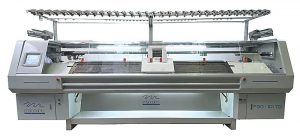
Founded in 2011 in Conegliano, Mandarin Knitting Technology is situated in northeast Italy’s Veneto region — an area renowned for knitwear production by giants like Benetton and Stefanel. Its ITMA exhibition highlight was the F20 101 TD in 1.5 gauge — a remarkable machine. Presented with a 1.5-gauge needle fitted with an enlarged hook, the machine can be knitted at a half gauge, effectively achieving a gauge of 0.75. Mandarin affirmed this to be the world’s coarsest flat knitting gauge. Notably, a 0.75-gauge F20 101 TD machine has found application in crafting carpets by an Italian rug manufacturer. This machine could be used in the bustling home furnishing market.
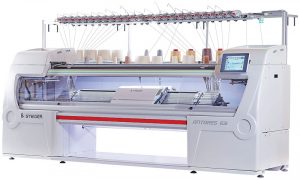
Switzerland-based Steiger Participation SA unveiled the four needlebed KS3-60MC-II, which marked a pivotal departure from its China-based parent company Ningbo Cixing Co. Ltd.’s prototype showcased in past textile machinery exhibitions. This momentous step integrates the Steiger brand into the Cixing Group’s flat knitting machines produced in China, shifting from earlier attempts to establish the Cixing identity beyond Chinese borders.
The Steiger KS3-60MC-II, presented as an 18-gauge model at ITMA 2023, was more than a prototype, but still awaits finalization before its market debut. This machine’s imminent market entry is anticipated at the threshold of the cutting-edge realm of four-needlebed technology. Steiger Sales Manager Gianni Zamarco indicated that meticulous testing involving Steiger’s clientele will precede its official release. Bearing a single head and three-system configuration, the KS3-60MC-II boasts a substantial 60-inch needle bed, attaining speeds of up to 1.6 meters per second. Standard models encompass 16 motorized yarn carriers. The takedown mechanism involves a flexible device, comb, and auxiliary roller apparatus complete with segmented adjustments. Steiger also unveiled a novel 3-gauge Antares 2.185 flat knitting machine. This distinct Swiss creation features 24 motorized yarn carriers, which caters to crafting coarse gauge intarsia sweater panels.
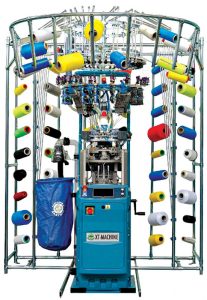
Shoe Technology
Italy-based Lonati S.p.A. exhibited one of the most exciting knitting concepts at the show. Lonati Group, global technology company HP and sporting company Decathlon collaborated to unveil an innovative manufacturing paradigm that harnesses 3D printing. Their endeavor represents an eco-conscious approach to shoe production, employing cutting-edge technologies — HP’s Multi Jet Fusion and Lonati’s shoe-upper knitting machines — thereby redefining the creation of sustainable footwear.
Traditionally, the footwear manufacturing process necessitates multiple components, adhesives and extensive labor. However, HP, Decathlon, and Lonati have pioneered a transformative method, presenting a sports shoe that encapsulates the future of footwear. This distinctive shoe seamlessly integrates Lonati’s intricate sock with a 3D-printed midsole and out-sole created using HP’s Jet Fusion 5200 printer. Lonati’s XT-MACHINE and Double Cylinder E1530XS knit-ting machines allow single or double-layer fabric uppers to be made, blending comfort, performance, lightweight and quality.
The sole is 3D printed using Ultrasint® TPU01 thermoplastic polyurethane (TPU) powder from BASF for shock absorption, energy return and flexibility.
The collaboration underscores the industrial potential of 3D printing and digital knitting, accentuating the following focal points:
Personalization — The shoe presents extensive customization options, allowing consumers to tailor their footwear per individual preferences.
Sustainability and Repairability —The glue-free assembly approach facilitates seamless shoe repairs, avoiding the need to discard the entire shoe. Segregating cushion and upper components enables targeted fixes, prolonging product life and minimizing waste. Employing a single material, TPU, for grip and cushion elements enhances recyclability, contributing to an ecologically conscious product life cycle.
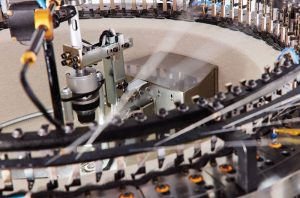
Circular Knitting Innovations
Taiwan-based Pailung is a global provider of circular textile machinery and solutions with a rich history and a strong reputation in the textile industry. Pailung’s advanced knitting machines, KS3B PLUS HS and KD3.2B PLUS, enhance fabric production speed, energy efficiency and capacity. The KS3B PLUS HS offers versatility with six fabric types and a maximum speed factor of 1350. To boost versatility, the machine can be modified using a conversion kit to further produce terry and 3-end fleece fabrics. On the other hand, the KD3.2B PLUS surpasses its predecessor in crafting six fabric types at an increased capacity.
Pailung’s innovative fabric technology can produce recyclable high pile fabrics without the need for adhesives. The Cozy Collection encompasses eco-friendly, warm, and versatile high-density, two-sided and three-layer high-pile fabrics. In-line with sustainability goals, these adhesive-free winterwear options ensure recyclability and durability. Pailung’s approach to high-pile fabric involves layered knitting to reduce labor, time, and power consumption, while preserving design flexibility. Enhanced fiber control during knit-ting amplifies design possibilities and minimizes subsequent shearing. Distinct from sliver knit fabric, Pailung’s high pile fabric achieves similar density using a unique circular knitting production process that directly creates fibers on the fabric, yielding lighter, denser, and fur-like textures that are unique.
To reduce waste and eliminate the chance of faulty fabric reaching a customer, Pailung has developed the Fabric Defect Detection system, which employs advanced computer vision and cameras within the knitting machine to stop fabric defects from continually occurring. Fabric waste translates into economic losses as well as an environmental impact. The system monitors production in real time and if a defect is identified, the machine halts.
Pailung’s AlterKnit is an evolved rendition of inverse plating, functioning by interweaving alternating yarns into the fabric’s framework. Using circular knitting machines, this process fuses yarns of varying colors or compositions within the same row. AlterKnit caters to the fashion and apparel sector, providing textile designers and manufacturers with the means to create intricate patterns incorporated directly into the knit structure, which eliminates the necessity for post-production printing or dyeing. This technology yields clear patterns with well-defined edges — a noticeable advancement over conventional inverse plating. Elements such as sports team emblems, complete with text and logos, may be created in the fabric. Single-knit AlterKnit styles also are reversible, with two mirrored iterations of the same design — comprising up to four colors — on either side.
Pailung also offers a comprehensive software suite. The Knitting Fabric Management System (KFMS) archives knitting data, facilitating the replication of fabric production. This knowledge transfer to the factory empowers any technician to reproduce saved styles. The Pailung Online Monitoring System (POMS) centrally oversees multiple knitting machines. Linked with KFMS-stored materials and parameters, POMS permits remote control, scheduling, and monitoring using a dashboard. Integration of KFMS, POMS, and the Manufacturing Execution System (MES) enhances textile factory ERP functionality. These systems can supply data to the ERP for resource management, error analysis and operational insights.
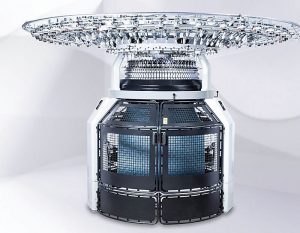
Germany-based Mayer & Cie.’s prominent offering, the Relanit 3.2 HS, stands as a highly favored machine among customers, notably for its superior productivity in elastomeric plating. This mechanical single jersey model handles a diverse spectrum of yarns and qualities, boasting consistent reliability. It excels in energy efficiency, consuming up to 30-percent less energy than traditional circular knitting machines. The latest version of Relanit 3.2 HS incorporates an enhanced yarn guide, streamlining elastic thread feeding and facilitating retrofitting for existing units.
Among Mayer & Cie.’s repertoire tailored for mattress cover fabrics, the OVJA 2.4 EM is preeminent. Within a 38-inch diameter, it produces up to 30 kilograms of coveted 300 grams per square meter fabric hourly. This dual-layer apparatus extends its capabilities to encompass spacer fabric knitting in E18 to E20 gauges. Exhibited at ITMA, the machine adeptly crafts spacer fabric with intricate perforations, supported by the thread fluctuation system in alternate units that maintain constant tension and thwart thread irregularities. The OVJA 2.4 EM is further refined with a novel horizontal yarn guide, enhancing its reliability and user-friendliness. Accommodating thicker weft yarns with a larger bore, this innovation eliminates the need for rib dial height adjustments and bolster hold-down function, which is crucial for extended floats.
In response to prevailing trends in the apparel sector, Mayer & Cie. introduced the SF4-3.2 III. This machine ingeniously amalgamates elements from the S4 3.2 II and MBF 3.2, catering to the demand for lightweight elastic three-thread fleece fabrics, including cotton blends. Significantly, its impeccable plating prowess is demonstrated through discreet background yarn, removing the necessity for double dyeing in most cases.
In summation, Mayer & Cie.’s trio of machines — Relanit 3.2 HS, OVJA 2.4 EM, and SF4-3.2 III — epitomize the synergy of innovation, efficiency, and adaptability in contemporary knitting technology.
Warp Knitting Advances
ITMA 2023 witnessed Karl Mayer’s introduction of pioneering warp knitting machinery. The RSJFS 4/1 EL, 130 inch, E14 raschel machine stood out. Capable of intricately woven patterns and designs in both flat and circular knit aesthetics, it offers remarkable productivity. Its ability to work with staple fibers enhances sustainability, including 100-percent cotton and coarser yarns in the jacquard bars.
A debutant, the RDPJ 6/2 EL MC, 138 inch, introduces a double-bar raschel machine, revolutionizing spacer fabric design. Innovations in color and jacquard techniques permit vibrant multicolor designs, making these textiles appealing to fashion, footwear, and home sectors. The elimination of dyeing via the use of spun-dyed yarns reduces environmental impact and costs.
The HKS 3-M ON, E 32, 130 inch embodies digital tricot excellence. Leveraging cloud pattern data, this model ensures rapid adaptation to trends with reproducible patterns. Notably swift and efficient, it employs advanced yarn feed innovation for seamless production.
At ITMA 2023, Karl Mayer show-cased a myriad of samples to show the capabilities of its machinery. Everything from warp knit seamless garments devoid of seams and a 3D-seamless collection featuring relief-like designs to the warp-knit-ted crochet-knit fabrics made using 100-percent cotton and next-generation 4D-Knit insulating, two-color-effect spacer fabrics were on display. Among lace innovations, Karl Mayer showcased elastane-inclusive variants with exceptional wash resistance. Karl Mayer’s presentation encompassed a spectrum of inventive textiles with diverse applications that will continue to inspire the textile industry.
Trajectory Towards Sustainability, Digitalization
In conclusion, the recently concluded ITMA 2023, renowned as the pinnacle event in the textile machinery exhibition realm, marked a notable juncture. This ITMA ushered the textile industry into a dynamic phase characterized by its trajectory toward both sustainability and digitalization. Functioning as an avant-garde global showcase, ITMA 2023 substantiated its role as a premier platform for catalyzing innovation within the textile domain. Ranging from eco-conscious materials and processes to waste mitigation and conscientious manufacturing, ITMA 2023 underscored the non-negotiable importance of sustainability for a prosperous future. Knitting in general has always been an industry where technology innovation goes beyond sheer performance and speed. The engineers and technicians at these machinery companies have added amazing features that drive brands in the fashion and industrial world to think differently. It will be interesting to see the developments for consumers when these innovations get into the hands of the knitting designers.
September/October 2023




